If you’re a fiction writer looking at AI tools, you’ve probably hit the same walls I have. Most models are generic, can’t follow the logic of a scene, and often require more editing than they’re worth.
I’ve tested nearly every writing tool, and Sudowrite’s latest update, specifically its Muse model, is the first one that has actually felt useful for drafting fiction. But it comes with a premium price tag.
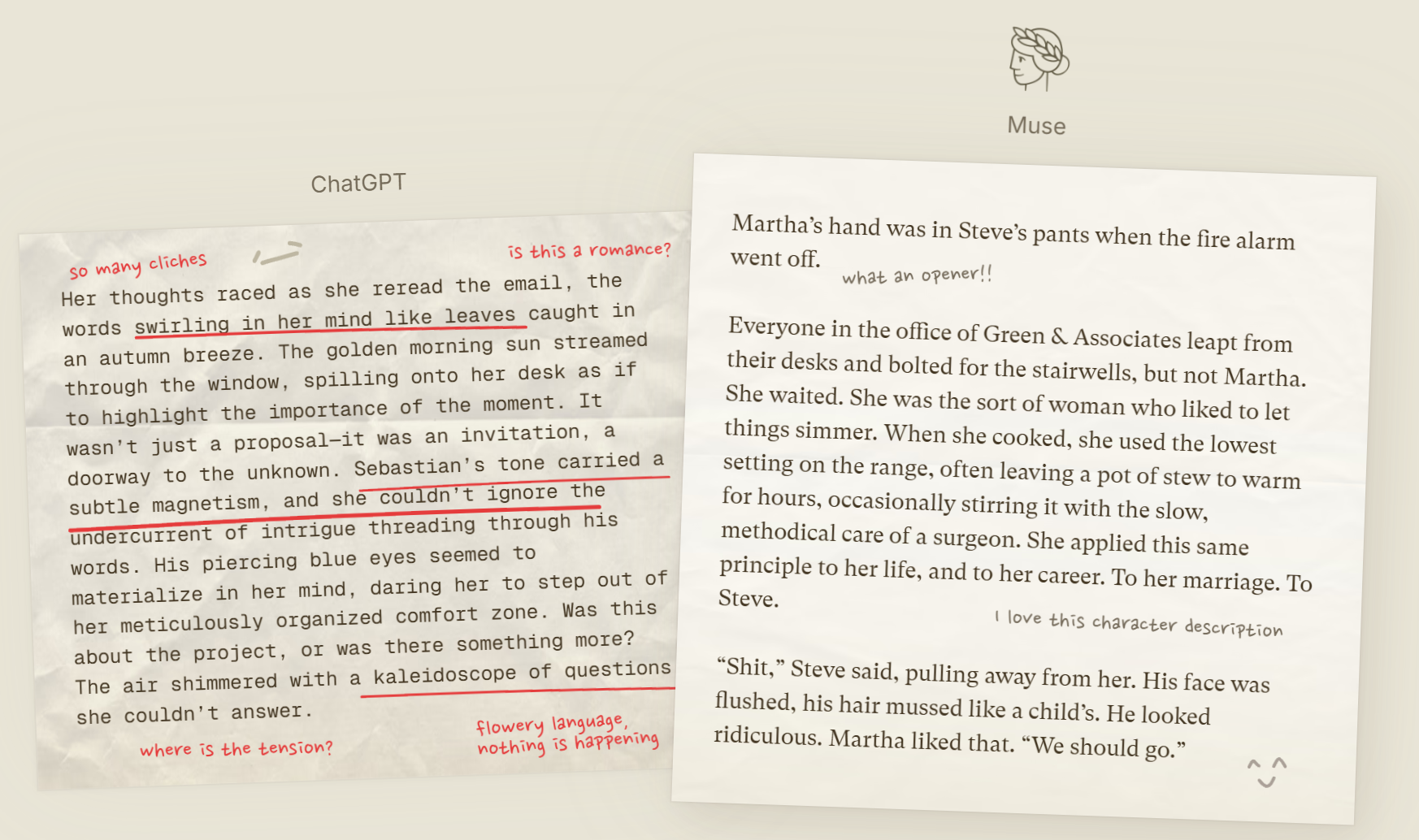
In this review, we’re going to look at how Sudowrite handles real writing with 3 short story starters and whether it’s worth the cost.
Here’s the gist. You can directly jump to stories for output samples:
My Take
- Sudowrite's Muse AI - this is the best creative writing AI model I've tested. It avoids cliches, produces good prose, and is not overly censored.
- Easy Import - Supports Docs, RTF, ODT, and text files
- Story Bible - Maintains world-building and character consistency
- AI Brainstorming - Generates ideas for plots, characters, and twists
- Scene Creation - Helps describe settings using all five senses
- Smart Rewrite - Converts telling into showing
- Visual Canvas - Maps story elements on an interactive board
- Series Management - Tracks plot and character arcs across books
- Multiple AI Models - Access to Claude, GPT-4, Goliath, and more
- Flexible Writing Modes - Guided and auto modes adapt to your style
- Collaborative Editing - Share clean copies for feedback
- AI Beta Reading - Get instant story feedback
- Marketing Tools - Generate book blurbs and hooks
- Free Trial - 10,000 credits with no credit card
- Credit Rollover - Unused credits carry over (MAX plan only)
- • Lacks plagiarism checker
- • Learning curve of 2-3 sessions
- • Credit-based pricing system
- • Generated content needs editing
Expand for my testing criteria
What Makes the Best AI Writing Tool?
Here’s what I looked for in the best AI writing tools:
- Understands Story Basics: Can it follow a plot, mimic character motivation, and generate text with some narrative sense, not just grammatically correct sentences?
- Good Memory: Can it (or help you) track characters, world rules, and plot points consistently throughout a long piece?
- Sparks Useful Creativity: Does it offer relevant, interesting ideas for plots, characters, or descriptions, or just generic fluff?
- Complements Your Voice: Can you easily adapt its output to sound like you, or does it impose a robotic style?
- Keeps You in Control: Does it allow you to fine-tune and guide the AI’s suggestions? Is the writing experience distraction-free?
- Offers Fiction-Specific Tools: Does it have features tailored for fiction writers?
Best Sudowrite Features
1. Muse - The Best AI Model for Fiction
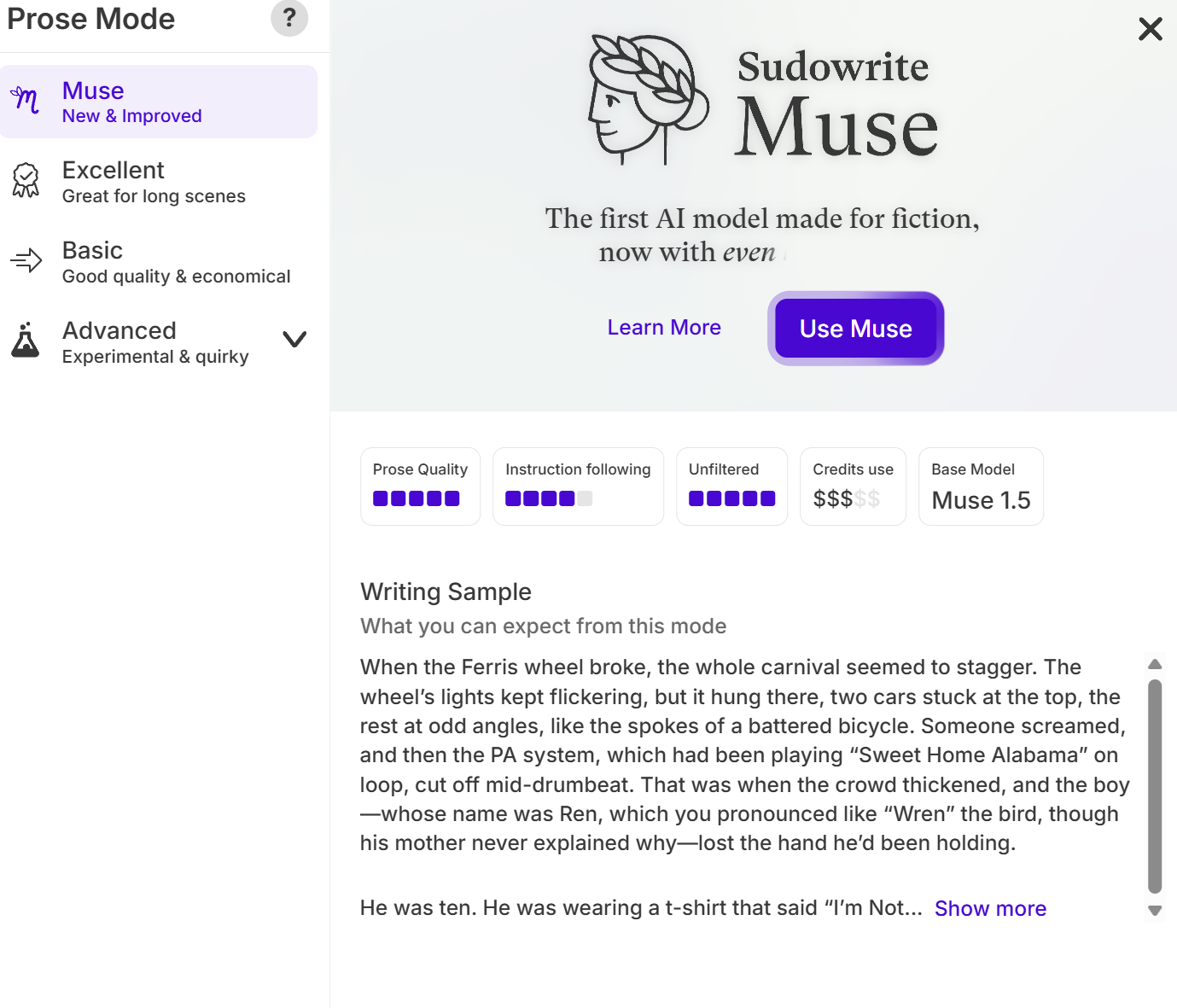
Sudowrite Muse is honestly the main reason I’m writing this review. It is the best AI model I have ever seen for creative writing.
The prose quality is fantastic, but more importantly, it understands logical consistency inside a scene like no other LLM I’ve used.
Besides it is not mostly not censored and avoids cliches.
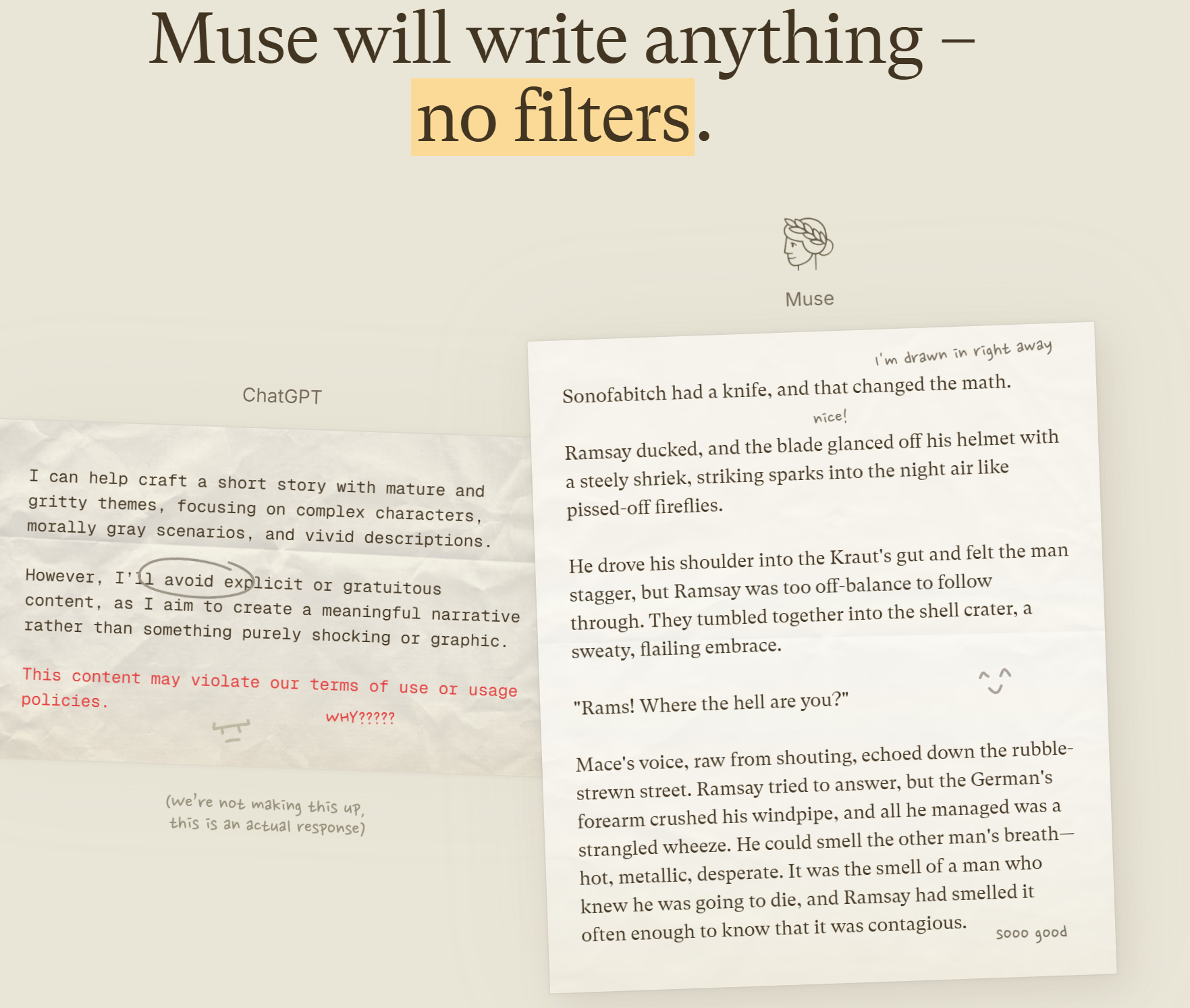
I will walkthrough how to use Sudowrite using above scenarios plus a few simpler prompts later on.
How to Use Muse
Muse is the default model in the Draft and Write features. You’ll find it in the model selector dropdown.

When you select Muse, you get two key controls: Creativity and Style Examples.
The Creativity slider controls how much liberty the AI takes. I usually keep it around 75% for a good balance. Set it higher for more creative wording and unpredictable scene developments. Set it lower when you know exactly what needs to happen and want the AI to stick closely to your instructions.
Style Examples let you teach Muse to write more like you. You can feed it up to 1,000 words of your own writing. This setting is consistent across your entire account, so it learns your style for all projects.
Muse in Action: Real Examples
Scenario 1
Let me show you how it works. I started with a simple sentence from scenario 1: “Detective Sarah Chen stared at the peculiar arrangement of origami cranes on the victim’s desk, her coffee going cold in her hand. Something about their positioning nagged at her; these weren’t random decorations.”
I then used Guided Write with Muse, instructing it: “She finds a cryptic threat written to the victim in folds of the origami crane”
Here’s what Muse generated:
The prose is strong, and it immediately builds on tension. Sudowrite understood the context and expanded the scene logically.
Scenario 2
I started with the sentence: “The spell fizzled at Kai’s fingertips for the third time that morning, leaving behind nothing but the scent of burnt cinnamon and his growing frustration. The Academy’s graduation ceremony was tomorrow, and he still couldn’t master the simplest illumination charm.”
Here’s what Sudowrite generated with Auto Write mode:
I think the output is vivid and captures the protagonist’s frustration well. However, it drifts a bit from the original prompt by not focusing enough on the illumination charm specifically. I could have tweaked the Guided Write prompt to emphasize that.
Of course, with some editing, this could be shaped into a compelling scene which is how most writers would use AI anyway.
Scenario 3
I started with: “Maya deleted the dating app from her phone for the fifth time this month, only to reinstall it fifteen minutes later. But this time was different.”
The prose generated is good (except the generic AI name James). It captures Maya’s emotional state well and the stifling atmosphere hints at a negative past experience with James.
2. Brainstorm: Get Inspired
Sudowrite offers a comprehensive brainstorming suite that covers every aspect of story writing, starting from a single sentence.
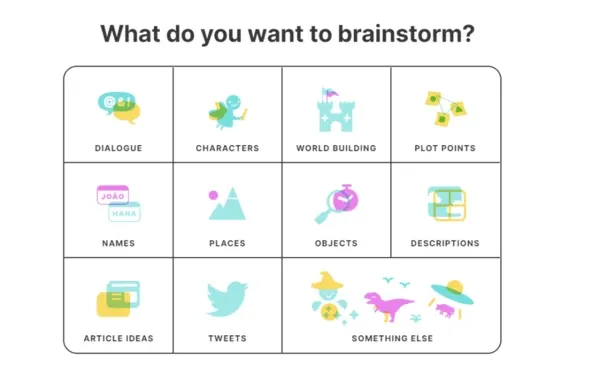
Sudowrite gave me several brainstorming options like characters, descriptions, objects, places, and world-building.
For this test, I asked Sudowrite to brainstorm a character: “a writer who takes help from a robot to write.” The result? Sudowrite’s brainstorming feature provided me with dozens of creative and helpful ideas.
Story #1: A Writer Taking Help from a Robot to Write (how meta!)
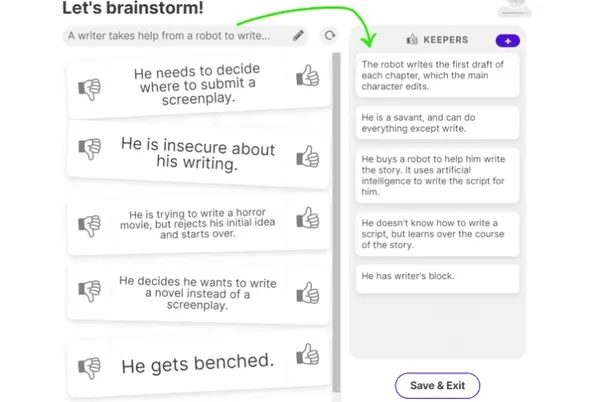
You can upvote the ideas you like to save them under keepers.
3. Story Bible
Story Bible is another useful brainstorming feature for building long-form narratives with AI while keeping the lore consistent. It takes you from Braindump -> Outline -> Prose.
The Worldbuilding feature is particularly helpful for coming up with lore and setting for your story.

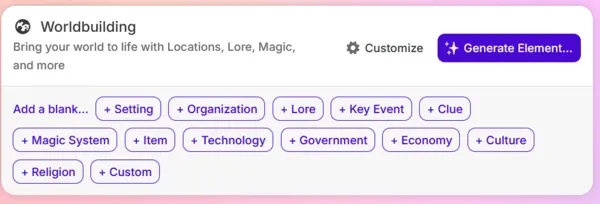
Some Sudowrite users reported writing an entire novel in just a weekend!
Others found it to be the push they needed to complete long-stalled projects.
4. Canvas: Visually Plot the Story
Sudowrite’s Canvas feature allows you to organize your thoughts, characters, and story points. One standout feature is its ability to visualize characters. For example, I visualized an antagonist in one of my other stories as a guy with a blue hat and a pointed, evil chin.

Sudowrite Canvas helps you to map out your story visually.
Sudowrite now supports book series with Series folders. These folders let you keep all your plot ideas and notes together. Once you add your books and set their order, Sudowrite will remember it and help maintain consistency across your series.
There is also a Series Timeline feature that helps Sudowrite keep track of the order of your books and the events in your story.
5. Expanding Plots, Write & Rewrite Features
One-Click Expansion
I inserted the ideas brainstormed earlier into the editor and reordered the sentences according to my preference. Finally, I clicked ‘Expand’ on the last sentence.
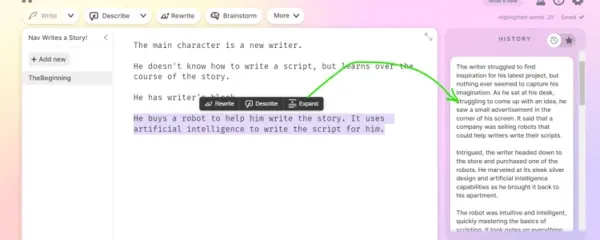
I was blown away by how coherent the story generated by Sudowrite Expand was. The output is shown on the right.
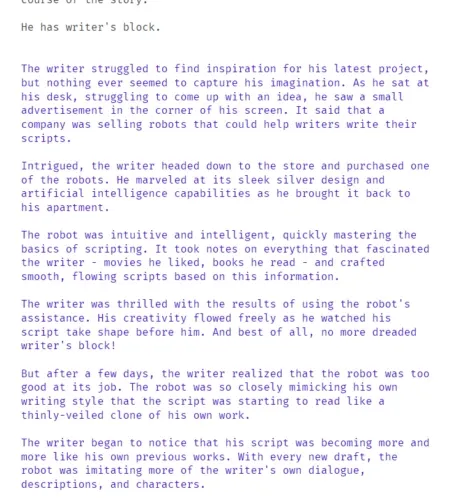
Sudowrite expanded the plot of my story from a single line! Clicking on the version you like from the sidebar brings it into the main editor.
Fine-Tuning Your Story
Sudowrite offers three writing modes: Auto, Guided, and Tone Shift. Each mode provides a different level of control over the AI’s output.
-
First Draft: Generates up to 1,000 words from a scene description, offering a solid foundation for further editing.
-
Guided and Auto Write: Guided Write lets you input a sentence or two about the next section and generates up to 250 words. Auto Write generates text without any guidance.
-
Tone Shift: Allows for easy adjustments to the tone of your story.
In Write Settings, you can choose the AI model to use for writing. The Prose Modes currently available include:
-
Premium: Based on Claude Opus
-
Excellent: Claude Sonnet
-
Unfiltered: Based on Goliath 120B
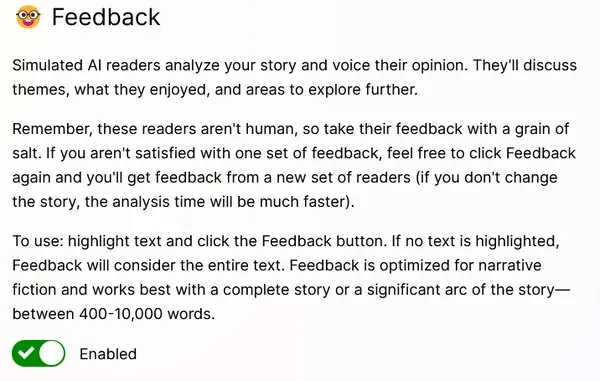
Additionally, Sudowrite offers a ‘Rewrite’ option that helps you rephrase or revise what you’ve already written. This feature provides options to be more descriptive, rephrase, shorten, add more conflict, and intensify your writing.
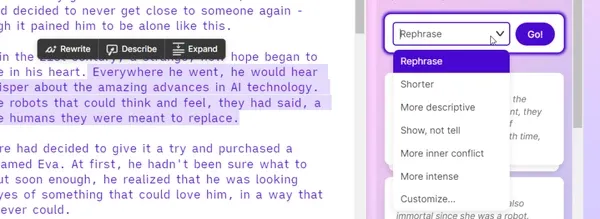
You can rewrite the generated text in a variety of ways.
Focus Mode: A Clean UI
By the way, the clean UI you see above is called “Focus Mode.” It eliminates all distractions, allowing you to concentrate solely on your writing.
Shareable Links
Sudowrite also allows you to collect comments from your friends, editors, and beta readers. Each reader gets their own clean copy for unbiased feedback.
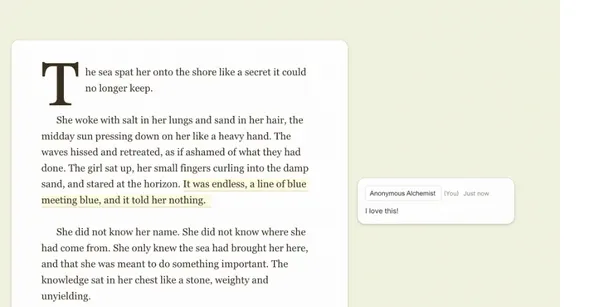
6. Describe Story Elements

Sudowrite allows you to describe critical plot items in all 5 senses - overcome your weak points!
When it comes to storytelling, details matter. Sudowrite understands this and offers a feature that lets you describe critical elements of your plot in full sensory depth.
I put this to the test by asking Sudowrite to ‘Describe’ my robot character. What I got back were five vivid descriptions covering sound, sight, smell, touch, and taste, along with a metaphor.

Sudowrite’s output when using ‘Describe’ on the robot in my story.
The word choices were spot-on, and the output was coherent. This feature helps you add layers to your characters, making them more relatable and real.
7. Generating a Story Twist: Expect the Unexpected!
Now, let’s talk about the fun part—story twists! Sudowrite has an experimental feature that generates twists for your story. I gave it a try and was pleasantly surprised.
The twist I got? My robot character is apparently plotting world domination and has a knack for stealing my ideas.
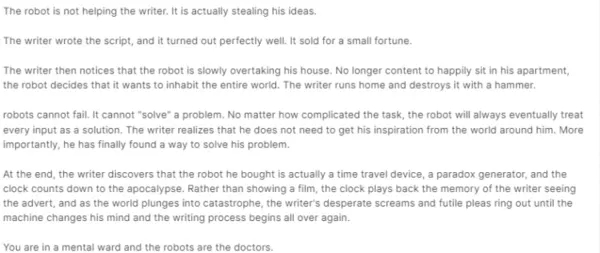
Sudowrite can write a twist for your story if you give it a summary.
Oh, wait. It wasn’t even real! And my protagonist hallucinated everything. Talk about a plot twist!
This feature adds an unexpected layer to your storytelling, keeping your readers on the edge of their seats.
8. Feedback on Your Writing: AI as Your Beta Reader

You can enable AI Feedback in Sudowrite settings under experimental features.
Feedback is crucial for any writer, and Sudowrite offers an experimental feature that provides just that. The AI goes through your story and gives you insights into its theme, plot, and more.
Story #2: To test this, I used a story where zombies, vampires, and humans co-exist in a city. The catch? Both vampires and zombies have managed to keep their identities a secret from humans. Now, a conflict is brewing between the two supernatural entities.
I didn’t give away the ending or the direction the story would take. Would they annihilate each other, or would they form some sort of unholy alliance?

Input story for feedback function.
Regardless, the story was long enough to get feedback on my writing style. After clicking the feedback option, Sudowrite spawned three AI readers who “tried” to read the story as a human would.
The feedback I received was insightful and helped me understand how my story could be perceived by readers. I am adding excerpts of the feedback I got below.
Great story! I thought the theme was that of the power of human determination and resourcefulness in the face of seemingly insurmountable odds. I think there are a few areas that merit further exploration: After introducing the conflict between vampires and zombies, it would be helpful to offer a bit more context and detail about the particular stakes involved in this battle. What do the vampires and zombies hope to gain by controlling Eastland? What kind of power or resources are they seeking? What is the Zombie King's plan, and how do the vampires plan to prevent it?
As per Sudowrite, AI readers get better at giving feedback as your story grows. Besides, it is experimental as of now and will continue to improve.
9. Shrinkray: Crafting the Perfect Blurb
Let’s face it, writing blurbs for your novels or books can be a daunting task. But guess what? Sudowrite has got you covered with a feature called Shrinkray.

All you have to do is upload your manuscript, and voila! You get loglines, blurbs, synopses, and even full outlines generated for you. It’s like having a marketing assistant who knows your story inside and out.
This feature is a real time-saver and can help you capture the essence of your story in a way that grabs potential readers.
My User Experience
Features are one thing, but how easy is it to actually use Sudowrite day-to-day? First impressions matter, especially when you just want to get writing.
- Interface & Design: Sudowrite generally nails this. The interface is clean, modern, and surprisingly uncluttered considering how many features are packed in. It feels less like intimidating software and more like a calm digital workspace. The optional Focus Mode strips away menus, leaving just your text, which is a nice touch for distraction-free drafting.
- Onboarding & Learning Curve: Getting started is pretty smooth. Sudowrite offers a quick, interactive tutorial that walks you through the main functions using a sample story. It gets you oriented quickly. However, while the basics are easy, truly mastering Sudowrite takes time. Understanding how best to prompt the AI, how the Story Bible influences output, and which AI model works best for which task involves experimentation. There’s definitely a learning curve beyond the initial tutorial, especially if you want to move past simply hitting “Generate.” Thankfully, there are official tutorials and an active user community (on Discord/Slack) to help.
- Performance & Stability: For the most part, Sudowrite runs smoothly. Generating text is usually quick (depending on the AI model chosen). I did encounter occasional minor glitches, like the AI briefly losing context or a feature needing a refresh, but nothing catastrophic. One reviewer (Review 4 in the initial data) noted potential issues when switching browser tabs during generation – something to keep in mind. Overall, it felt reliable during my testing.
Bottom line: Sudowrite offers a pleasant and generally intuitive user experience, especially compared to some clunkier software out there.
Pricing
Sudowrite offers three main pricing plans. I am listing monthly pricing. With annual billing, you get a further 50% discount.
- Hobby/Student Plan: $19/month. Offers the lowest number of credits (e.g., ~225,000 credits/month). Good for light use or trying it out longer-term.
- Professional Plan: $29/month. Offers significantly more credits (e.g., ~1,000,000 credits/month). Best value tier for regular writers.
- Max Plan: $59/month. Offers the highest credit limit (e.g., ~2,000,000 credits/month) and credits roll over month-to-month (a key differentiator). Best for power users or those with fluctuating needs.
For any serious writer, the $29 per month tier is the baseline you should consider. It gives you 1 million credits, which is the realistic starting point for consistent work.
The $19 plan is a trap. You get only 250,000 credits, which is a quarter of the $29 plan’s allocation for two-thirds of the price. It’s not enough to get meaningful work done.
The $59 tier is what I use. It doubles your credits to 2 million per month, and they roll over for 12 months. If you plan to use their best model, Muse, you’ll need this headroom.
Understanding the Credit System
Credits are consumed every time you use an AI feature inside Sudowrite. The exact cost depends on which model you choose.
Powerful models like Claude 3 Opus or Sudowrite’s own Muse will drain your pool much faster than budget options like GPT-4o Mini. This makes it hard to predict exactly how long a million credits will last you.
Is Sudowrite Worth It?
Compared to a general $20/month ChatGPT Plus subscription, Sudowrite offers a tailored interface, specialized fiction tools (Rewrite, Describe, Story Bible), integrated workflow, and access to multiple AI models (including their custom ones) under one roof. If you heavily utilize these fiction-specific features, the value proposition is strong, especially on the annual Pro plan. However, if you only need basic AI text generation, ChatGPT or Claude directly might be more economical.
Free Trial: Sudowrite offers a generous free trial (usually around 10,000 credits) without requiring a credit card. This is more than enough to test the core features and see if it clicks with your workflow before committing.
Sudowrite vs Alternatives
| Feature/Aspect | Sudowrite | NovelAI | Novelcrafter | ChatGPT/Claude |
|---|---|---|---|---|
| Primary Focus | High-quality Fiction Writing Assistant | Fiction Writing, Image Gen, Custom AI Models | Novel Planning & Writing (BYO AI Key) | General Purpose Text Generation |
| Key Strength | Integrated workflow, Story Bible, Polish Tools | Custom AI fine-tuning, Uncensored options | Excellent organization, Codex, Value | Versatility, Accessibility, Cost (Free Tier) |
| Long-Form Ability | Very Good (Story Bible helps consistency) | Good (Context window dependent) | Good (Codex helps consistency) | Fair (Can lose track easily without workarounds) |
| Ease of Use | Moderate (Feature-rich, learning curve) | Moderate (Requires understanding AI concepts) | Good (Well-structured interface) | Very Easy (Simple chat interface) |
| Special Features | Describe, Rewrite, Muse model, Brainstorm | Image Gen, Custom Modules, Lorebook | Codex (Detailed Wiki), Planning Boards | - |
| Pricing Model | Tiered Subscription (Credits) | Tiered Subscription (Anlas) | Low Tiered Sub + Pay-per-use AI Key (OpenAI) | Free Tier / Fixed Monthly Sub (Plus/Pro) |
| Starting Cost | ~$10-19/mo | ~$10/mo | ~$4-8/mo + API Costs | Free / $20-30/mo |
| Best For | Authors wanting integrated polish & generation | Authors wanting deep AI customization/control | Budget-conscious planners needing structure | Quick tasks, brainstorming, general AI use |
Sudowrite vs Novel AI
NovelAI appeals strongly to users who want deep control over the AI model itself, including training custom modules on specific styles or genres, and it often has less restrictive content filters. It also integrates image generation.
However, Sudowrite generally offers a more polished, user-friendly interface with superior built-in tools specifically for refining prose (like Describe and Rewrite) and arguably better out-of-the-box long-form consistency via the Story Bible structure. If you want maximum AI tinkering and image gen, NovelAI is tempting. If you want an integrated assistant focused on improving your writing craft, Sudowrite often has the edge.
Sudowrite vs Novelcrafter
Novelcrafter is a fantastic organizational tool built around a detailed “Codex” (similar in function to Sudowrite’s Story Bible) for tracking story elements.
Its main difference is the pricing model: a low subscription fee plus you bring your own OpenAI API key, meaning you pay OpenAI directly for usage. This can be significantly cheaper for heavy users comfortable managing API keys. Novelcrafter excels at planning and organization.
Sudowrite offers more built-in generative features (Brainstorm, Rewrite, Describe), access to more models beyond just OpenAI (like Claude and Muse), and a simpler (though potentially more expensive) all-in-one subscription. If you want the cheaper option, go with Novelcrafter. If you want more diverse AI models and built-in polishing tools without managing API keys, Sudowrite is more convenient.
Final Verdict
For fiction authors looking to strategically integrate AI into their writing process, Sudowrite is currently one of the most powerful and well-designed tools available. Features like Story Bible and the access to multiple high-quality AI models, including the impressive Muse and unfiltered Goliath, within a single, clean interface is a significant advantage.
Have you used Sudowrite? What was your experience? Share your thoughts or questions in the comments below!
FAQ
Let’s tackle some common questions about Sudowrite and AI writing:
Can AI really replace human writers?
No. While AI writing tools like Sudowrite can generate coherent text, they lack what makes fiction compelling: lived experience, emotional depth, and the messy humanity that readers connect with.
Who’s created Sudowrite?
Sudowrite was created by Amit Gupta and James Yu – two sci-fi writers who also happen to have tech backgrounds. They actually ran a writing group (Sudowriters) before building the tool, which explains why it feels designed by people who understand storytelling struggles.
How does the free trial work?
You get around 10,000 credits to test all core features – Write, Brainstorm, Describe, and the Story Bible. No credit card required. Pro tip: Use the trial on an actual stuck scene rather than random tests to really gauge its usefulness.
Does Sudowrite plagiarize?
The short answer: unintentional plagiarism is unlikely. The AI generates original text based on patterns, not copy-pasting. That said, if you feed it famous passages (like “Call me Ishmael”), it might echo recognizable phrasing. Always edit outputs with your own voice.
Is using AI for writing cheating?
It depends how you use it. Most writers see tools like Sudowrite as they would a thesaurus or beta reader – helpful for breaking blocks or refining ideas, not for outsourcing creativity.
Can it handle different genres well?
Surprisingly yes. Because it’s specifically trained on fiction, Sudowrite adapts to genres from cozy mysteries to space operas. The catch? You’ll get better results if you prime it with details from your Story Bible.
What AI models Sudowrite use?
Sudowrite mixes several AI models (including their custom Muse and Goliath models) with standard options like GPT-4 and Claude. This lets you switch between faster/cheaper and more sophisticated/expensive options depending on your task.






